Simulating the Evolution of the Land and Water Resource System under Different Climates in Heilongjiang Province, China
Abstract
:1. Introduction
2. The Study Area
3. The Model and Data Sources
3.1. System Dynamics
3.2. Constructing the Model
3.3. Data Sources
4. The Simulation Model and Results Analysis
4.1. Model Testing
4.2. Simulating the Evolution of the Land and Water Resource System under Different Climates
4.3. Simulation of the Land and Water Resource System under Different Scenarios
4.3.1. The Subsystems’ Variable Selection and the Scenarios
4.3.2. Simulations under Each Scenario
5. Discussion
6. Conclusions and Future Research
- Through establishing an SD model of the land and water resource system for Heilongjiang Province, this study analyzed the evolution of the system under different climates and concluded that the region faced a risk of supply and demand of land and water resources. This step clarified the problem and the direction of managing regional land and water resources.
- This paper shows the evolution of regional land and water resources as a result of many driving forces. This study selected and adjusted the variables (i.e., net irrigation quota for paddy fields, water quota for industrial use, forestland area, annual change rate of farmland area, the annual growth rate of industrial gross) to set different scenarios. The model simulated the evolution and analyzed the results and then combined the favorable scenarios to predict the evolution of regional land and water resources in Heilongjiang Province. Through simulation under different scenarios, it can be seen that water-saving technologies can reduce water use, and the policy of returning farmland to forestland can reduce the ecological risk of land use. Decreasing the economic development rate can alleviate the pressure of water shortage. Combining these strategies can promote the healthy evolution of regional land and water resources in the region.
- The SD model can simulate the dynamic relationships between the variables, as well as predict the response of the land and water resource system to climate change and relevant policies. However, this model has a limitation. Precipitation has a certain impact on the evolution of the system, but it is not accurate and is difficult to predict. Follow-up studies can introduce hydrological considerations into the SD method to reasonably predict precipitation.
- The model is complicated. The land and water resource system is extremely complex and involves many factors. The research process is still uncertain and lacks mature theoretical research. In view of this, the SD model of land and water resources established by previous scholars can be summarized and analyzed, and the insufficiency of the land and water resource system model of this study can be improved to explore a multi-perspective comprehensive SD model of land and water resources that is suitable for regional conditions so that improved analysis and prediction of land and water resource systems can be achieved.
- The method is simple. The system dynamics analysis method of the land and water resource system in this study is relatively simple, and the analysis result is one-sided. Therefore, in future research, scholars should focus on the complementary expansion of multiple methods and should seek a more reasonable multidisciplinary interactive system to achieve the qualitative and quantitative analysis of land and water resource systems and to obtain more comprehensive research results.
Author Contributions
Funding
Acknowledgments
Conflicts of Interest
References
- Abdul, G.; Manzoor, G.; Ghulam, M. Review Agriculture in the Indus Plains: Sustainability of Land and Water Resources. Int. J. Agric. Biol. 2002, 4, 429–437. [Google Scholar]
- Cuceloglu, G.; Abbaspour, K.; Ozturk, I. Assessing the Water-Resources Potential of Istanbul by Using a Soil and Water Assessment Tool (SWAT) Hydrological Model. Water 2017, 9, 814. [Google Scholar] [CrossRef]
- Wang, Z.L.; Jiang, Q.X.; Fu, Q.; Jiang, X.; Mo, K. Eco-environmental effects of water resources development and utilization in the Sanjiang Plain, Northeast China. Water Sci. Technol. Water Supply 2017. [Google Scholar] [CrossRef]
- Forrester, J.W. Industrial Dynamics; Productivity Press: Cambridge MA, USA, 1961. [Google Scholar]
- Richardson, G.P. System Dynamics: Simulation for Policy Analysis from a Feedback Perspective. In Qualitative Simulation Modeling and Analysis; Springer: New York, NY, USA, 1991. [Google Scholar]
- Senge, P.M. The Fifth Discipline: The Art & Practice of the Learning Organization; Dell Publishing Group Inc.: New York, NY, USA, 1994. [Google Scholar]
- Homer J, B. Why we iterate: Scientific modeling in theory and practice. Syst. Dyn. Rev. 1996, 12, 1–19. [Google Scholar] [CrossRef]
- Sehlke, G.; Jacobson, J. System dynamics modeling of transboundary systems: The bear river basin model. Ground Water 2005, 43, 722–730. [Google Scholar] [CrossRef] [PubMed]
- Ren, Y.; Yao, J.; Xu, D.; Wang, Z. A comprehensive evaluation of regional water safety systems based on a similarity cloud model. Water Sci. Technol. A J. Int. Assoc. Water Pollut. Res. 2017, 76, 594. [Google Scholar] [CrossRef] [PubMed]
- Chen, Z.; Wei, S. Application of System Dynamics to Water Security Research. Water Resour. Manag. 2014, 28, 287–300. [Google Scholar] [CrossRef]
- Yin, S.; Dong, J.G.; Wei, C.S.; Wei, J.G. Integrated assessment and scenarios simulation of urban water security system in the southwest of China with system dynamics analysis. Water Sci. Technol. 2017, 76, 2255–2267. [Google Scholar] [CrossRef] [PubMed]
- Yilinuer, A.; Jilili, A.; Long, M.; Alim, S.; Michael, G. System Dynamics Modeling of Water Level Variations of Lake Issyk-Kul, Kyrgyzstan. Water 2017, 9, 989. [Google Scholar] [Green Version]
- Benjamin, L.T.; Hector, M.; Menendez, R.G.; Luis, O.T.; Alberto, S.A. System Dynamics Modeling for Agricultural and Natural Resource Management Issues: Review of Some Past Cases and Forecasting Future Roles. Water 2016, 5, 40. [Google Scholar] [Green Version]
- Liu, D.W. Risk assessment of water shortage in metropolitan area of Beijing, Tianjin and Hebei. Water Resour. Dev. Res. 2010, 10, 20–24. (In Chinese) [Google Scholar]
- Wei, H.X.; Li, Z.D. Ecological Risk Assessment of Water Resources Utilization in Gansu Province. Water Resour. Plan. Des. 2016, 29, 11–14. (In Chinese) [Google Scholar]
- Liu, Y.S.; Gan, H.; Zhang, F.G. Analysis of the Matching Patterns of Land and Water Resources in Northeast China. Acta Geogr. Sin. 2006, 61, 847–854. (In Chinese) [Google Scholar]
- Zhuang, D.F.; Liu, J.Y. Study on the model of regional differentiation of land use degree in China. J. Nat. Resour. 1997, 12, 105–111. (In Chinese) [Google Scholar]
- Wu, W.J.; Shi, P.J.; Hu, W. Study on land ecological risk in oasis city based on LUCC-a case study in the Ganzhou district. Arid Zone Res. 2012, 29, 122–128. [Google Scholar]
- Mo, H.H.; Ren, Z.Y. Study on Changes of Land Ecosystem Value and Ecological Risk: A Case Study in Sand Blowing Region: Over Shenmu County of Shaanxi Province. J. Desert Res. 2010, 30, 357–362. (In Chinese) [Google Scholar]
- National Bureau of Statistics of the People’s Republic of China. China Statistical Yearbook; China Statistics Press: Beijing, China, 2015.
- Bureau of Statistics of Heilongjiang Province. Heilongjiang Statistical Yearbook; China Statistics Press: Beijing, China, 2015.
- The People’s Government of Heilongjiang Province. The Thirteenth Five-Year Plan Outline for the National Economy and Social Development in Heilongjiang Province; The People’s Government of Heilongjiang Province: Heilongjiang, China, 2016.
- Land Resource Bureau. Heilongjiang Land Use Master Plan (2005–2020); Land Resource Bureau: Beijing, China, 2013. [Google Scholar]
- Erol, A.; Randhir, T.O. Climatic change impacts on the ecohydrology of Mediterranean watersheds. Clim. Chang. 2012, 114, 319–341. [Google Scholar] [CrossRef]
- Wang, X.J.; Zhang, J.Y.; Wang, J.H.; He, R.M.; Amgad, E.; Liu, J.H.; Wang, X.G.; King, D.; Shahid, S. Climate change and water resources management in Tuwei river basin of Northwest China. Mitig. Adapt. Strateg. Glob. Chang. 2014, 19, 107–120. [Google Scholar]
- Li, X.W.; Gao, X.Z.; Chang, Y.T.; Mu, D.P.; Liu, H.L.; Guo, J.Y. Water storage variations and their relation to climate factors over Central Asia and surrounding areas over 30 years. Water Sci. Technol. Water Supply 2017, ws2017206. [Google Scholar] [CrossRef] [Green Version]
- Balali, H.; Viaggi, D. Applying a System Dynamics Approach for Modeling Groundwater Dynamics to Depletion under Different Economical and Climate Change Scenarios. Water 2015, 7, 5258–5271. [Google Scholar] [CrossRef] [Green Version]
- Liu, J.Y.; Hu, Y.C.; Jin, X.Z. Sustainable utilization of water resources in Tianjin based on system dynamics. J. Huazhong Normal Univ. (Nat. Sci.) 2014, 48, 106–111. (In Chinese) [Google Scholar]
- Sun, X.X.; Shen, B.; Yu, J.L.; Liu, X.J.; Mo, S.H. Carrying capacity of water resources of Baoji city based on the system dynamics model. Xi’an Univ. Arch. Technol. (Nat. Sci. Ed.) 2007, 39, 72–77. (In Chinese) [Google Scholar] [CrossRef]
- Tong, F.; Jin, J.L.; Dong, Z.C. Study on regional joint allocation of water and land resources based on improved system dynamics model. Yangtze River 2017, 48, 43–48. (In Chinese) [Google Scholar]
- Nguyen, T.P.L.; Mula, L.; Cortignani, R.; Seddaiu, G.; Dono, G.; Virdis, S.G.P.; Pasqui, M.; Roggero, P.P. Perceptions of Present and Future Climate Change Impacts on Water Availability for Agricultural Systems in the Western Mediterranean Region. Water 2016, 8, 523. [Google Scholar] [CrossRef]
- Huang, R.; Liu, J.M.; Li, L.K. Water resources carrying capacity of Xianyang City based on system dynamics. J. Drain. Irrig. Mach. Eng. 2012, 30, 57–63. (In Chinese) [Google Scholar]
- Jiang, Q.; Fu, Q.; Wang, Z. Dynamic Simulation of Water Resources Sustainable Utilization of Kiamusze Based on System Dynamics. In Proceedings of the Sixth International Conference on Computer and Computing Technologies in Agriculture, Zhangjiajie, China, 19–21 October 2013; pp. 367–375. [Google Scholar]
- Sušnik, J.; Vamvakeridou-Lyroudia, L.S.; Savić, D.A.; Kapelan, Z. Integrated System Dynamics Modelling for water scarcity assessment: Case study of the Kairouan region. Sci. Total Environ. 2012, 440, 290–306. [Google Scholar] [CrossRef] [PubMed]
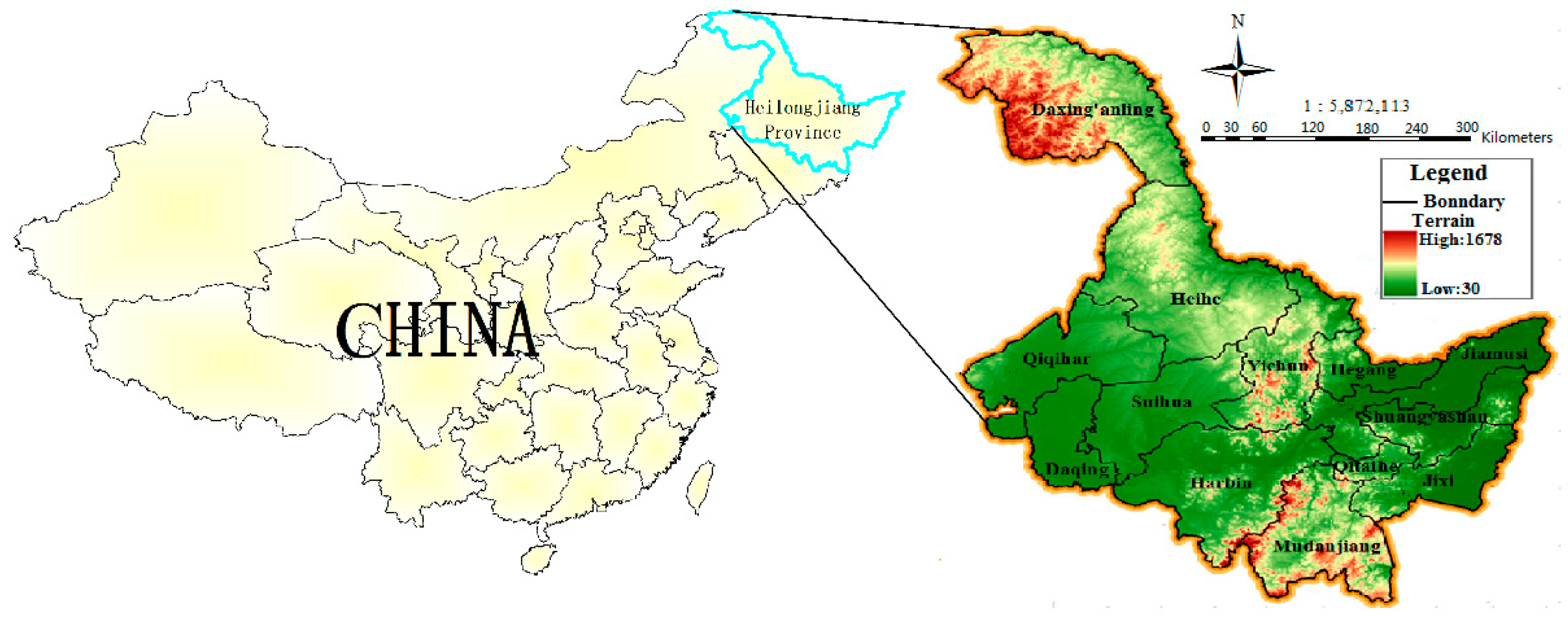
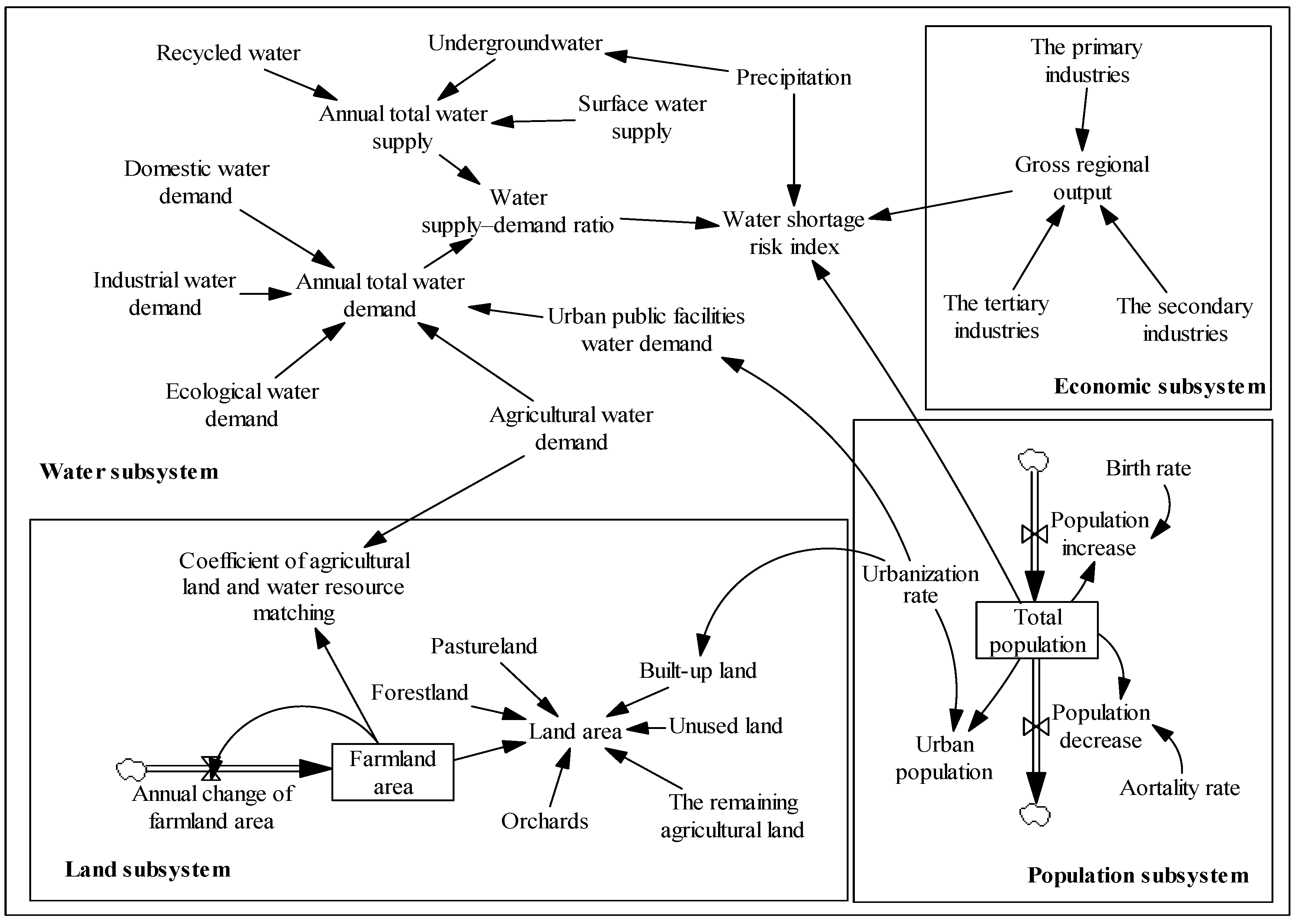
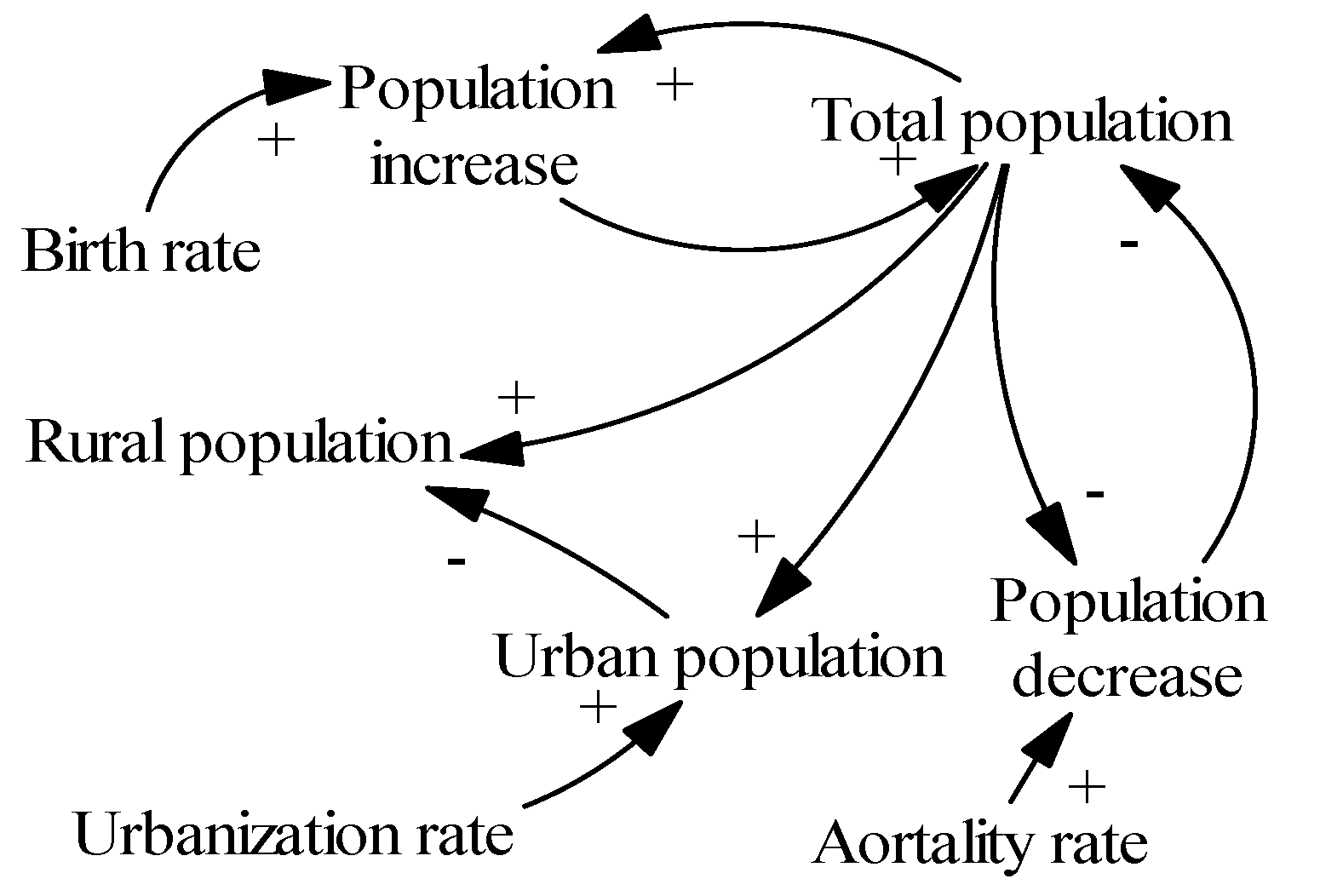

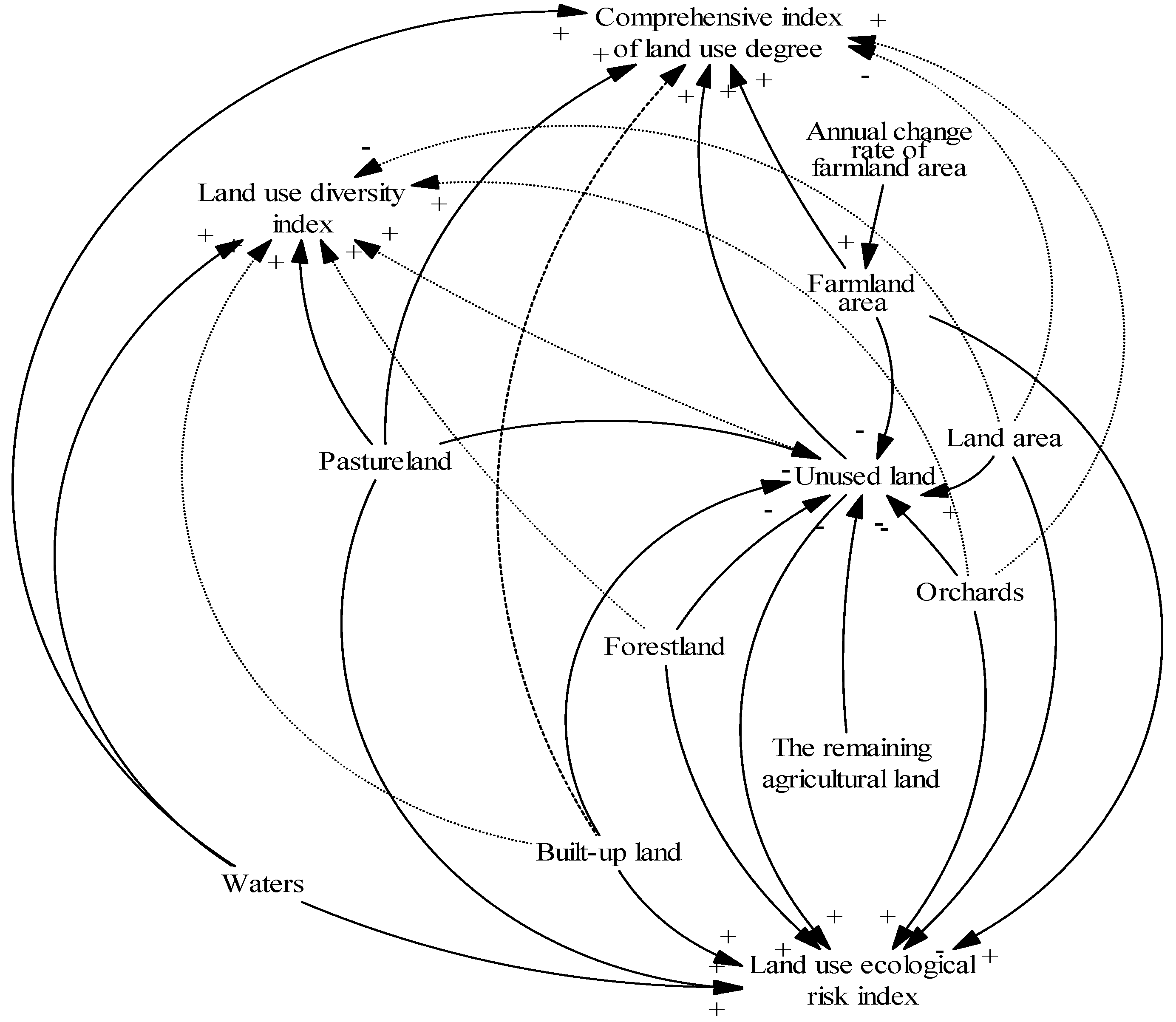
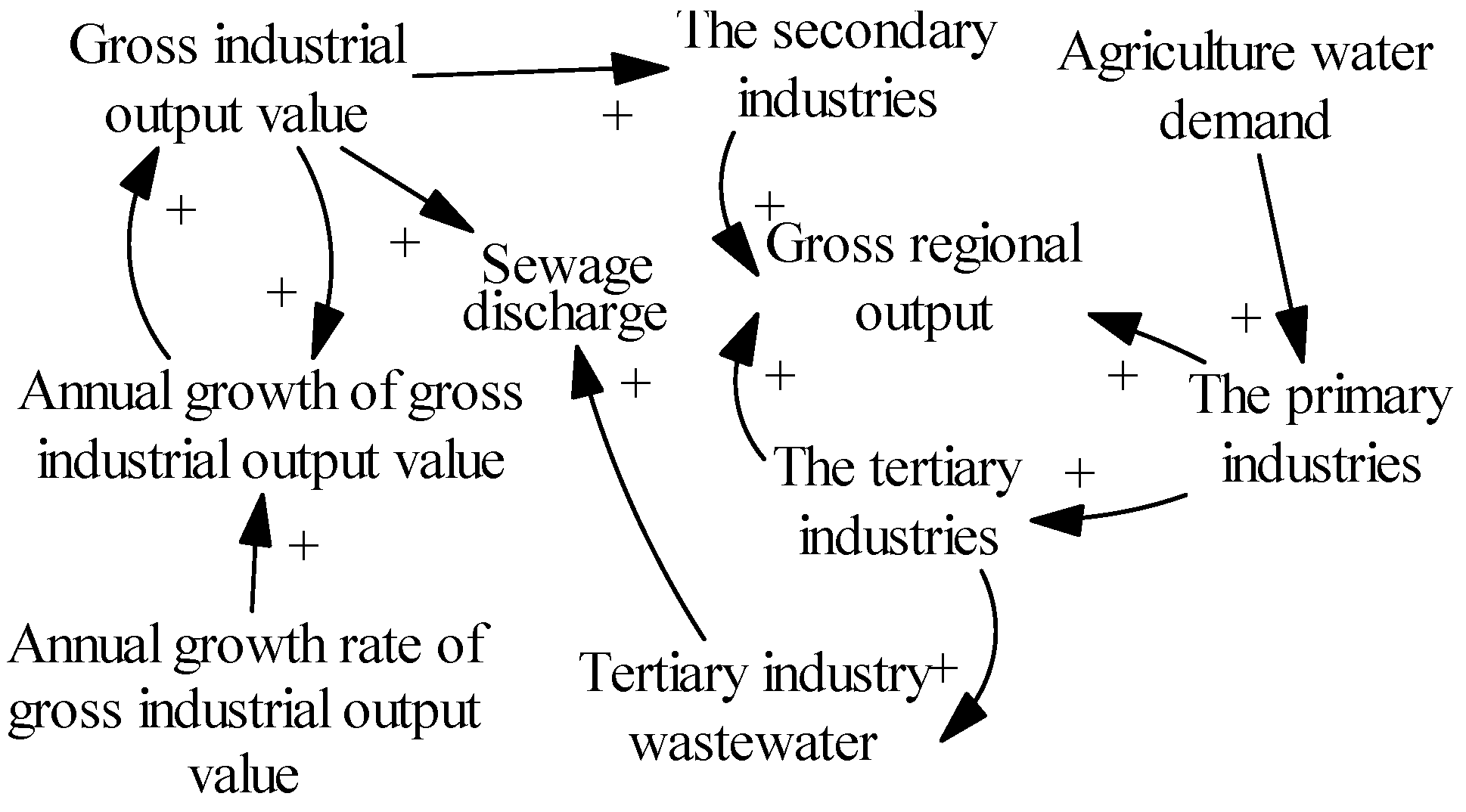
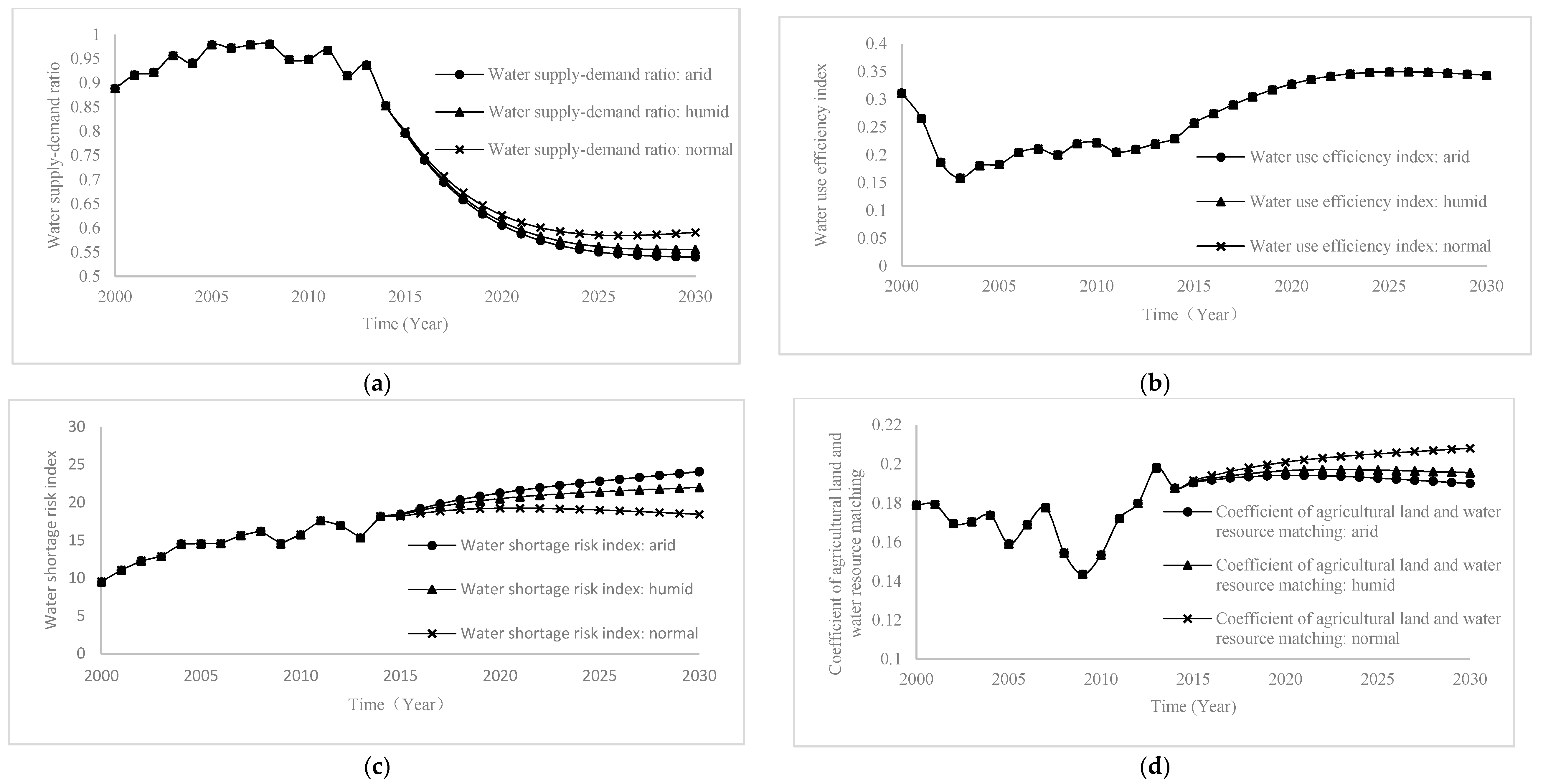
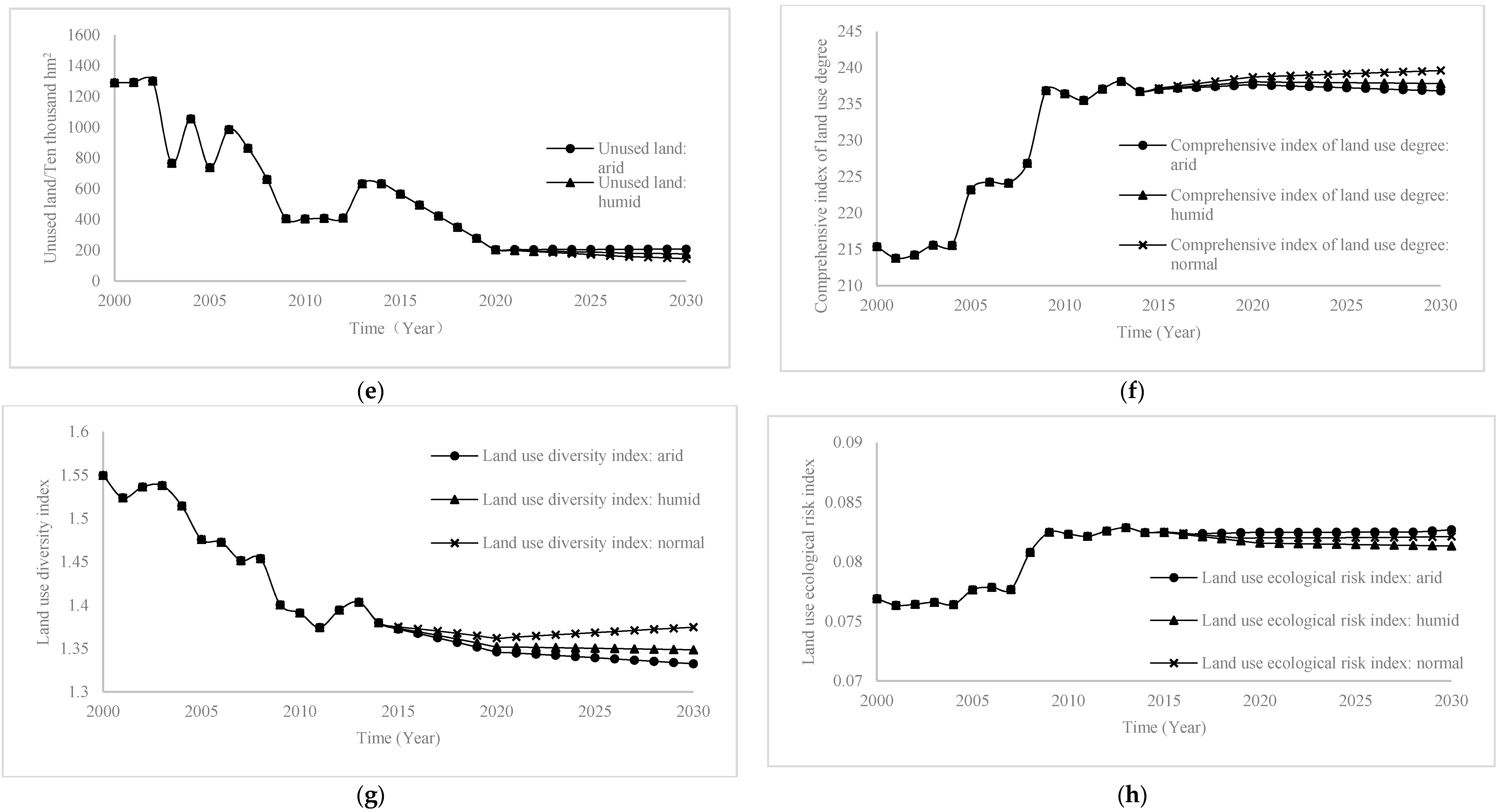
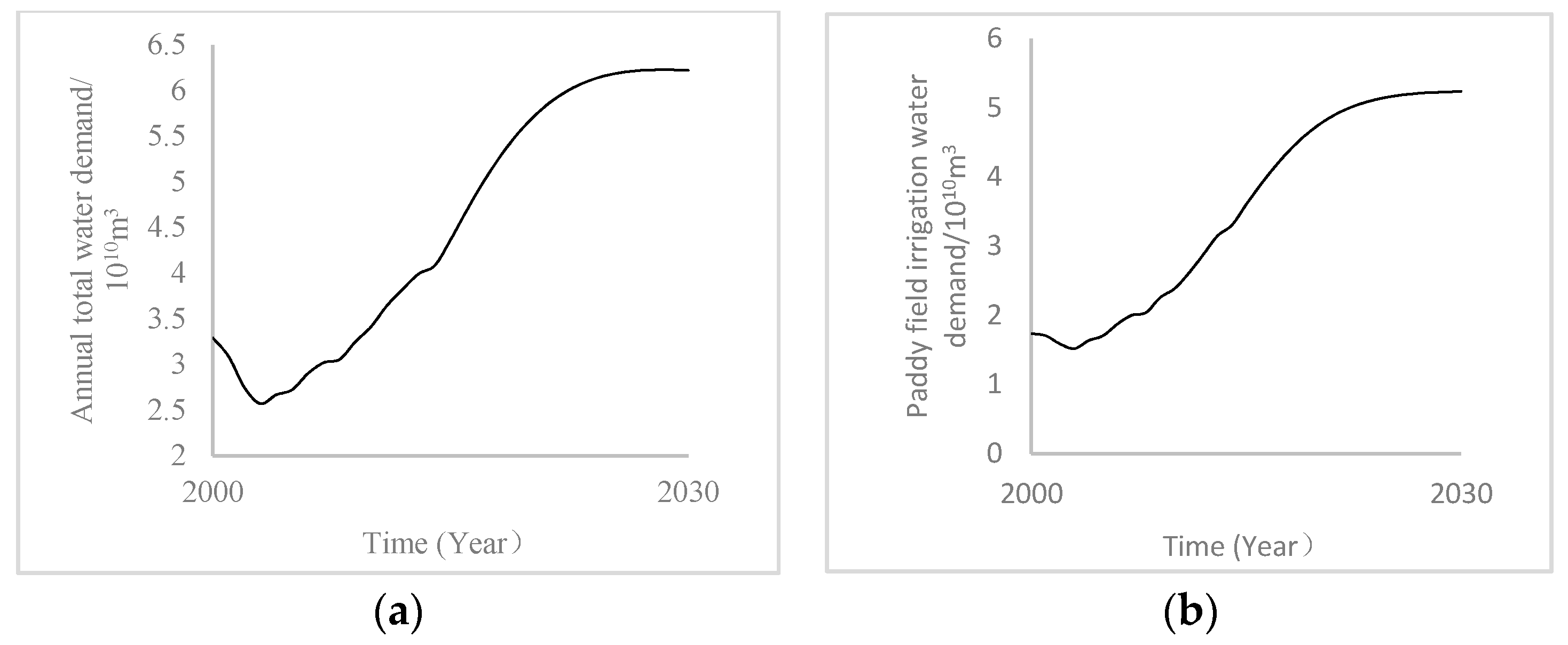
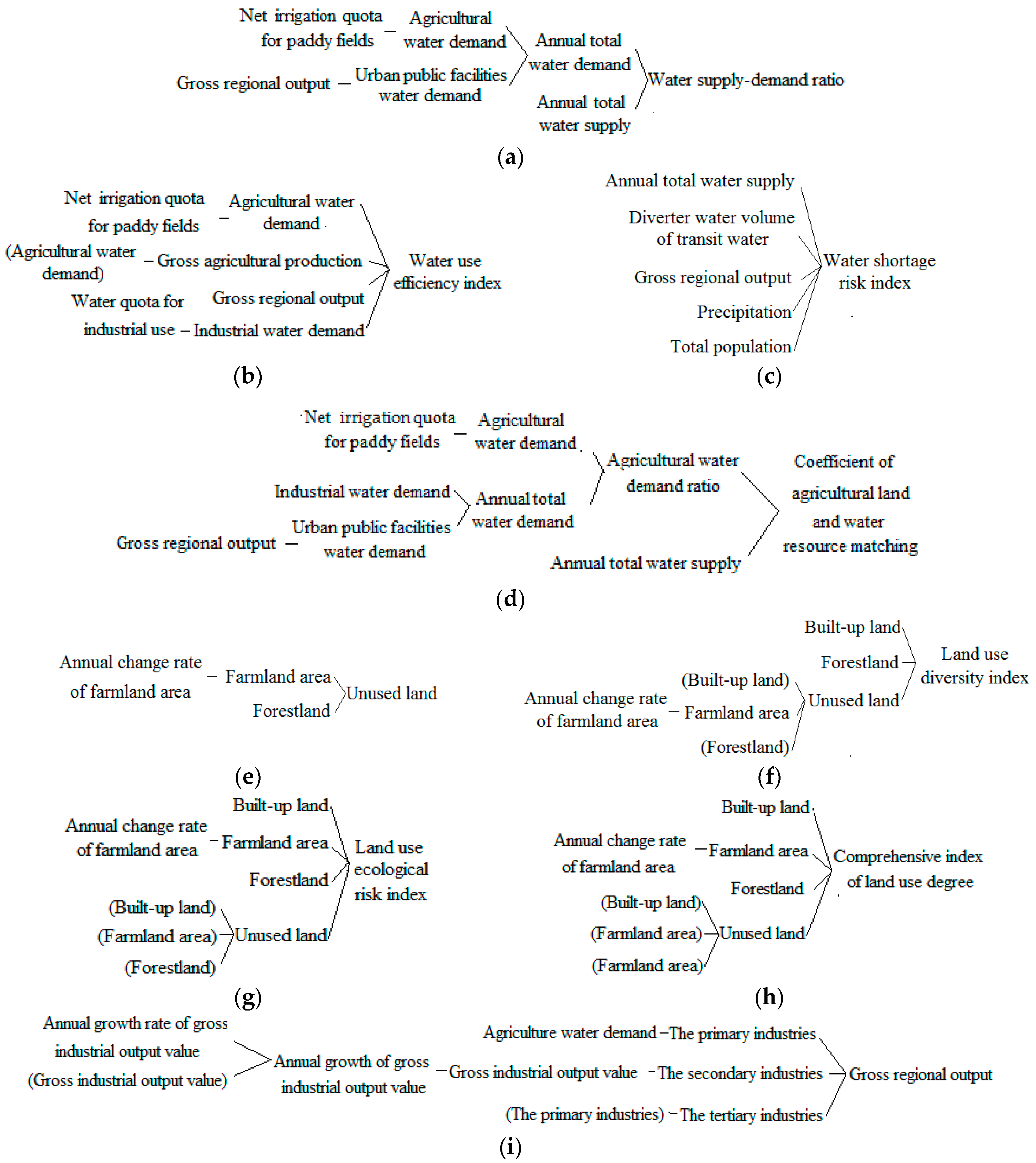
| Index | Variable | Unit | 2000 | 2002 | 2004 | 2006 | 2008 | 2010 | 2012 | 2014 | 2015 |
|---|---|---|---|---|---|---|---|---|---|---|---|
| Annual total water supply | Predicted value | 108 m3 | 287 | 249 | 251 | 282 | 300 | 324 | 350 | 348 | 348 |
| Actual value | 108 m3 | 297 | 252 | 259 | 286 | 297 | 325 | 359 | 364 | 355 | |
| Error | % | −3.48 | −1.20 | −3.19 | −1.42 | 1.00 | −0.31 | −2.57 | −4.60 | −2.01 | |
| Groundwater resources | Predicted value | 108 m3 | 275 | 247 | 262 | 268 | 236 | 285 | 285 | 282 | 282 |
| Actual value | 108 m3 | 268 | 270 | 274 | 279 | 248 | 278 | 290 | 295 | 283 | |
| Error | % | 2.55 | −9.31 | −4.58 | −4.10 | −5.08 | 2.46 | −1.75 | −4.61 | −0.35 | |
| Gross regional output | Predicted value | 108 Yuan | 2963 | 3375 | 4551 | 6233 | 8161 | 9976 | 14,398 | 15,247 | 15,440 |
| Actual value | 108 Yuan | 3151 | 3637 | 4751 | 6212 | 8314 | 10,369 | 13,692 | 15,039 | 15,490 | |
| Error | % | −6.34 | −7.76 | −4.39 | 0.34 | −1.87 | −3.94 | 4.90 | 1.36 | −0.32 | |
| Urbanizat-ion rate | Predicted value | % | 52 | 52 | 52 | 53 | 55 | 56 | 57 | 58 | 58 |
| Actual value | % | 52 | 53 | 53 | 53 | 55 | 56 | 57 | 58 | 59 | |
| Error | % | 0.00 | −1.92 | −1.92 | 0.00 | 0.00 | 0.00 | 0.00 | 0.00 | −1.72 |
| Variable | Scenario 1 | Scenario 2 | Scenario 3 | Scenario 4 | Scenario 5 |
|---|---|---|---|---|---|
| Net irrigation quota for paddy fields (m3/hm2) | Decrease by 20% | No change | No change | No change | No change |
| Water quota for industrial use (m3/hm2) | Decrease by 20% | No change | No change | No change | No change |
| Forestland (10,000 hm2) | No change | Increase by 20% | Decrease by 20% | No change | No change |
| Annual change rate of farmland area | No change | Decrease by 20% | Increase by 20% | No change | No change |
| Annual growth rate of gross industrial output value | No change | No change | No change | Maximum over the years | 0 |
| Variable | Scenario 1 | Scenario 2 | Scenario 3 | Scenario 4 | Scenario 5 |
|---|---|---|---|---|---|
| Unused land | - | 2.85% | - | - | - |
| Land use diversity index | - | −2.60% | 1.66% | - | - |
| Land use ecological risk index | - | −9.97% | 8.92% | - | - |
| Comprehensive index of land use degree | - | −3.09% | 2.67% | - | - |
| Water supply–demand ratio | 20.10% | - | - | −0.10% | 0.5% |
| Water use efficiency index | 17.81% | - | - | −7.81% | 3.59% |
| Water shortage risk index | −4.44% | - | - | 33.22% | −3.22% |
| Coefficient of agricultural land and water resource matching | −2.35% | 26.62% | −6.62%c | −6.62% | 0.86% |
| Variable | Unit | Status Quo | Combined Scenario | Change Range |
|---|---|---|---|---|
| Unused land | 10,000 hm2 | 207.4 | 251.9 | 21.46% |
| Land use diversity index | - | 1.27 | 1.24 | −2.05% |
| Land use ecological risk index | - | 0.08 | 0.07 | −9.78% |
| Comprehensive index of land use degree | - | 235.9 | 228.1 | −3.31% |
| Water supply–demand ratio | - | 0.56 | 0.65 | 17.45% |
| Water use efficiency index | - | 0.34 | 0.45 | 29.45% |
| Water shortage risk index | - | 24.08 | 22.49 | −6.60% |
| Coefficient of agricultural land and water resource matching | - | 0.19 | 0.23 | 22.18% |
© 2018 by the authors. Licensee MDPI, Basel, Switzerland. This article is an open access article distributed under the terms and conditions of the Creative Commons Attribution (CC BY) license (http://creativecommons.org/licenses/by/4.0/).
Share and Cite
Jiang, Q.; Zhao, Y.; Wang, Z.; Fu, Q.; Wang, T.; Zhou, Z.; Dong, Y. Simulating the Evolution of the Land and Water Resource System under Different Climates in Heilongjiang Province, China. Water 2018, 10, 868. https://doi.org/10.3390/w10070868
Jiang Q, Zhao Y, Wang Z, Fu Q, Wang T, Zhou Z, Dong Y. Simulating the Evolution of the Land and Water Resource System under Different Climates in Heilongjiang Province, China. Water. 2018; 10(7):868. https://doi.org/10.3390/w10070868
Chicago/Turabian StyleJiang, Qiuxiang, Youzhu Zhao, Zilong Wang, Qiang Fu, Tian Wang, Zhimei Zhou, and Yujie Dong. 2018. "Simulating the Evolution of the Land and Water Resource System under Different Climates in Heilongjiang Province, China" Water 10, no. 7: 868. https://doi.org/10.3390/w10070868
APA StyleJiang, Q., Zhao, Y., Wang, Z., Fu, Q., Wang, T., Zhou, Z., & Dong, Y. (2018). Simulating the Evolution of the Land and Water Resource System under Different Climates in Heilongjiang Province, China. Water, 10(7), 868. https://doi.org/10.3390/w10070868





